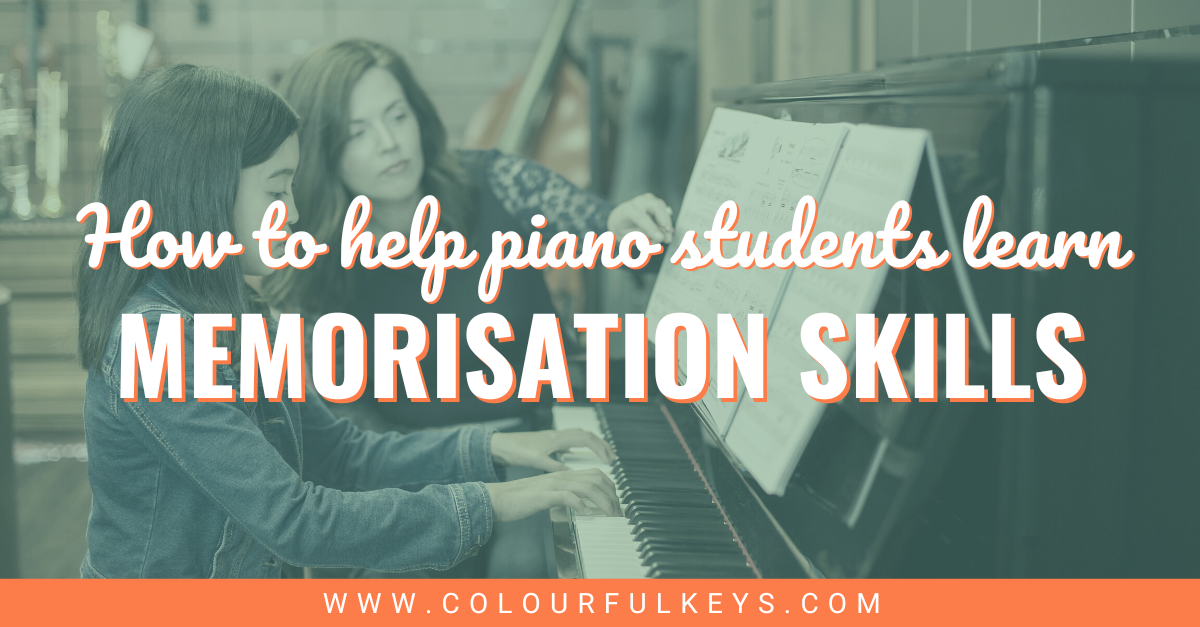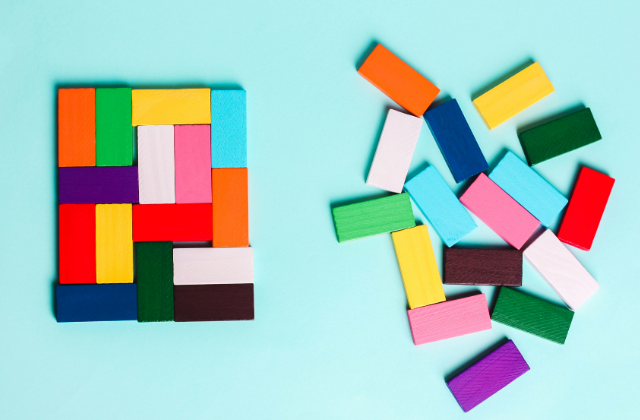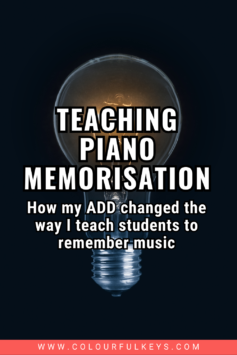
This blog post about how her ADD influences her approach to teaching piano memorisation was written by Samantha Rothschell. Samantha lives and teaches just outside of Nashville, Tennessee, USA. She holds a Bachelor of Music from Middle Tennessee State University. Samantha has taught for over 10 years in a variety of settings including public and private schools, private lessons, a homeschool co-op and class piano at the university level. You can find more information on her website.
A hallmark of many mental health conditions is memory issues. This is especially true for ADD. I’ve certainly had my fair share of memory problems!
I just haven’t always had the words to describe my struggles, or the tools to work through them successfully. But now I do, and it’s helped me grow as a musician and a teacher in so many ways.

I didn’t know that half of the mental health issues I dealt with had a name until my first year of undergraduate studies. And it was 10 years after graduation that I finally received a diagnosis for Attention Deficit Disorder (ADD).
It’s been a strange journey – full of painful healing and revelations – learning how my brain works and how it impacts my teaching style.
My Own Meandering Memorisation Journey
Through talk therapy and introspection, I’ve begun to realise that trouble with working memory is an issue I’ve dealt with for much longer than I ever realised.
Childhood
At the age of 5, I started taking piano lessons with my first teacher. I don’t remember how to play most of the pieces she taught me – let alone what their titles or composers are (except, of course, the A section of Für Elise and one sea shanty).
After my first teacher retired when I was around age 13, my parents didn’t look for a new piano teacher. However, in my senior year of high school (around age 17), our choir director – who was primarily a pianist – began offering group piano classes in school.
In class, my teacher basically treated me as if I was in private lessons. So I ended up spending most of class time in practice rooms, learning different pieces than the rest of the class was learning.
My Security Blanket: The Score
Neither of these teachers required me to memorise my music, let alone made it a point to teach me how to memorise it. There was no need since I never participated in festivals or competitions. I only performed in recitals and talent shows where memorisation wasn’t expected.
I loved having the music with me during performances. The score offered a sense of security – almost like Linus’ blanket, but for Schroeder. Even when my mind began to wander a bit, the score would draw me back in.
Memorisation Misadventure
When I decided to switch majors from psychology to music education after my first year of university, I was in a bit of a pickle.
Here’s how that went down:
- I chose two pieces I had previously learnt with my second piano teacher – a Beethoven sonata and a Chopin prelude.
- To memorise them, I simply played beginning-to-end over and over and over again, ad nauseam. (I was clueless as to what “form” was, or how to break a piece down into manageable chunks.)
- My focus was on the kinesthetics:
- How did my hands feel on the keys?
- Where were my arms?
- How did my fingers land in terms of the black keys?
It was a hot mess, and I’m very fortunate to have been accepted at all.
Memorisation Procrastination
Bless my college piano professor! It was she who took the time to teach me a more formulaic approach to memorisation at the piano. And it worked – for the most part. (I’m sure her patience ran thin with me often!)
However, I was still highly unorganised. I majorly struggled with making a plan, scheduling it and sticking to it.

I’d often procrastinate memorising pieces until I could perform them to the best of my ability with the music. Unfortunately, that also meant that I waited until the last moment, every single semester, to completely memorise anything.
Approaching Memorisation as a Teacher
My college professor did so much to help me develop memorisation skills that I still use them every time I’m teaching a piano student – regardless of our end goals.
But before a student and I get to work on memorising a piece, we must first consider the question:
Do they have to play by heart?
I do not require my students to memorise pieces or force them to participate in events that require memorisation. (Not everyone operates the same way as folks like Liszt!)
That doesn’t make any of us less valid as pianists. Because of my own challenges, I recognise that playing from memory isn’t the correct path for everyone.
That said, here are the considerations my students and I take when deciding if memorisation is appropriate:
- Does the student want to memorise a piece?
- Are they planning to participate in a festival or competition where memorisation is required?
- Would having the music in front of them at a recital make them more nervous, or would it act as a comforting reminder?
Memorising “As Needed”
We must also consider if the piece they’re studying requires certain techniques that are best approached when memorised:
- Large leaps in succession
- Clustered chords that look like ink blots on the music
- Fast movement where the pianist needs to look at their hands more than the page
Guess what? There is no rule that says a student has to memorise the entire piece!

They really can memorise just those measures with technical challenges, and use the sheet music the rest of the time. (I can think of quite a few Chopin mazurkas where this would be beneficial.)
Working the Memorisation Puzzle
If we ultimately decide it’s in the student’s best interest to memorise, we get to work. Here’s what we do (with inspiration from all of my teachers).
For more tips, advice and perspectives on memorisation, check out the Colourful Keys page devoted to teaching students how to practice.
Make a Plan
We look at our time frame, and make a plan together based on the end goal. This provides the student autonomy and responsibility, while also providing the framework needed to be successful.
Giving students a say in their own schedule makes it easier to hold them accountable, rather than just trying to “guess” if they’ll memorise it all by the due date.
Analyse the Form
Before we study a piece with the sheet music, we analyse the form.
Note: This is what we always do to start a piece in my studio, though I find it’s especially helpful when it comes to memorisation. Plus, if you use bright colours instead of the typical letters of A, B, A1, etc., it makes memorisation more like a puzzle. 🧩
Chunk It Up
Break up the work into smaller, more manageable chunks. That’s been the most helpful approach for myself as a neurodivergent learner, not to mention the neurotypicals I’ve taught.
Whether your student is memorising for an exam or memorising for a different purpose, Nicola’s ‘Painless Exam Prep Planner’ is a great tool to help you lay out the framework. Enter your info below and her team will send a copy straight to your inbox.

Subscribe to updates and get the Painless Exam Preparation Planner
Enter your details to subscribe to the newsletter for piano teachers with information, tips and offers.
I hate spam as much as you do! I’ll only send you information that’s directly relevant to music teachers and you can unsubscribe at any time.
Members of Vibrant Music Teaching can download the planner from the Printable Library. Not a member? Never heard of the membership? Find out what you’re missing by taking a tour today.
Start at the End
Begin either at the end of the piece or the most difficult part. Seriously.
What do audience members remember most from performances? The beginning and the end. Psychology.
Take Away the Score
Practise performing without the music during lessons, but don’t take it away too soon.
I usually have students play completely without their music in only the last 2 lessons before the memorised piece is due.
The Piano Teacher’s Role
Above all, our job as piano teachers is to support and encourage – and that includes the memorisation space. Don’t be surprised if students don’t remember as much as you think they should, or if they remember more.
I do my best to cultivate a judgement-free zone for my students, just as so many wonderful musicians continue to hold space for me.
Ask guiding questions, but don’t do all of the work for them. Here are some examples:
- Where are you now and where do you need to go?
- What is the interval between those leaps?
- How are you going to remember this measure?
Sometimes I also give examples of techniques I used when memorising similar pieces (even though I don’t have them memorised anymore).
There is so much variety in how the brain works, and there is so much beauty in that. Be flexible, and make your students a part of the process.

How do your own experiences influence your approach to teaching memorisation?
Share your thoughts in the comments below.